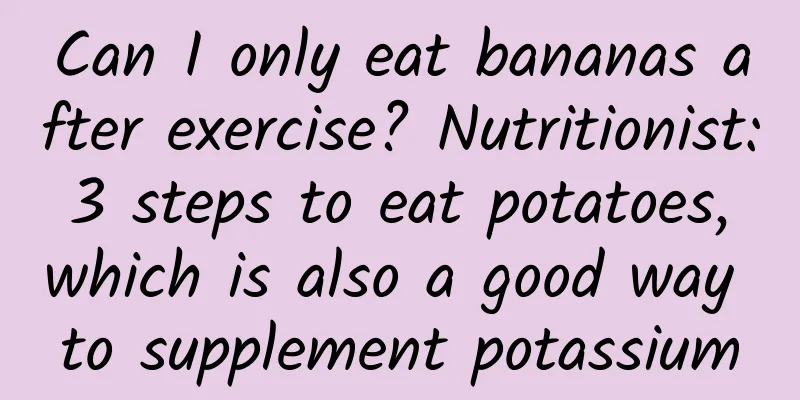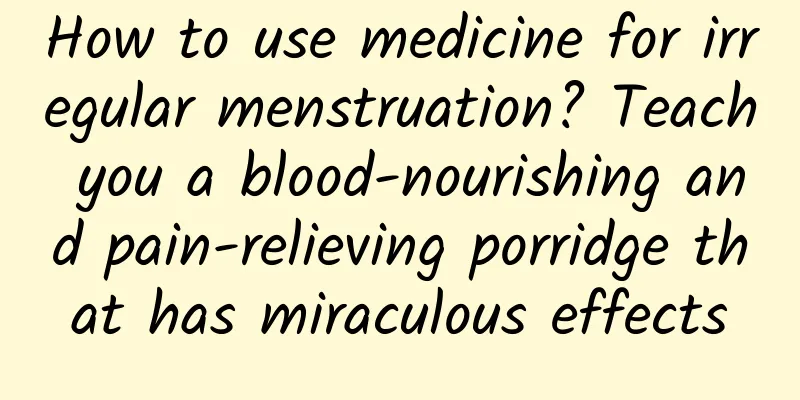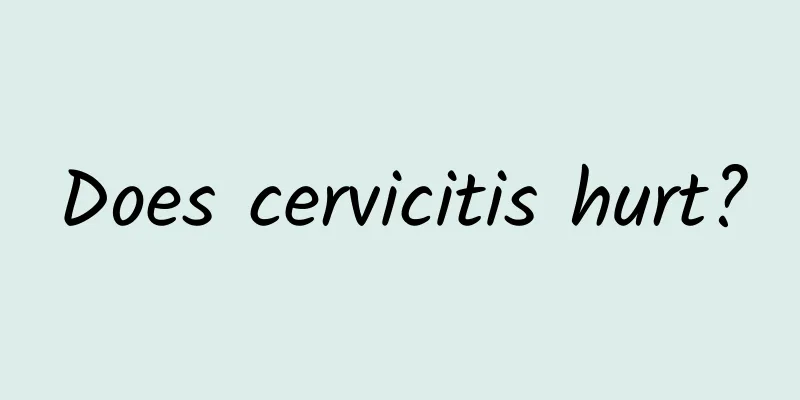Can I only eat bananas after exercise? Nutritionist: 3 steps to eat potatoes, which is also a good way to supplement potassium

|
Exercise is always the best way to lose weight! After a lot of exercise, many people not only sweat profusely, but also lose calories. At this time, they need to quickly replenish the glucose consumed after exercise, and the first thing that comes to mind is the "magic sports tonic" banana. Some people also choose to eat potatoes, believing that it can increase satiety and calories. Nutritionists remind us to be careful about the high GI value of potatoes, and suggest that after exercise, you may want to supplement with 5 kinds of light meals rich in sugar and protein, such as unsweetened soy milk with nuts, which is a smart choice that is healthy and burden-free. Sweating a lot after exercise causes potassium loss After a lot of exercise, the most worrying thing is potassium deficiency. There are three reasons for potassium deficiency in the human body: the first is that the human body sweats a lot in summer. In addition to water and sodium, sweat also contains a certain amount of potassium ions. The second is that people’s appetite decreases in summer, and the potassium ion intake from food is relatively reduced, which will cause insufficient potassium intake. Third, when the weather is hot, the human body consumes more energy, and energy metabolism requires the participation of potassium. To prevent low potassium, you need to supplement potassium and eat more potassium-rich fruits and vegetables To prevent hypokalemia, the key is to supplement potassium. Nutritionist Hong Ruopu from the Zhongxiao branch of Taipei Municipal United Hospital said that in clinical practice, oral administration of 10% potassium chloride solution can be used, and the safest and most effective method is to eat more fruits and vegetables rich in potassium. Fruits rich in potassium include: bananas, strawberries, citrus, grapes, grapefruit, watermelon, etc. Vegetables rich in potassium include: soybeans, mung beans, broad beans, kelp, seaweed, yellow croaker, chicken, milk, cornmeal, etc. also contain a certain amount of potassium. Various fruit juices, especially orange juice, are also rich in potassium and can replenish water and energy. Potassium deficiency can cause fatigue, shortness of breath, constipation, bloating, and occasionally quadriplegia. In severe cases, it can cause cramps, rhabdomyolysis, and muscle pain. People who suffer from long-term potassium deficiency will experience symptoms such as arrhythmia, abnormal nerve conduction, and vomiting. As for the loss of a large amount of water (for example: diarrhea and heavy sweating), in addition to replenishing water, you also need to replenish electrolytes. If you only replenish a large amount of water without replenishing electrolytes, you will experience symptoms of exhaustion such as weakness, cramps, vomiting, and diarrhea. Food sources of potassium include: meat, milk, cheese, fresh fruits and vegetables, oranges, raisins, potatoes, bananas, and winter melon, especially bananas which contain the most potassium. Potassium deficiency can cause fatigue, shortness of breath, constipation, bloating, and occasionally quadriplegia. In severe cases, it can cause cramps, rhabdomyolysis, and muscle pain. Eat potatoes to replenish calories after exercise? Nutritionists remind us to be careful about high GI values. Eat bananas after exercise to supplement potassium, prevent leg cramps, and increase exercise endurance Eating bananas to supplement potassium after exercise is a smart choice! Nutritionist Hong Ruopu said that after exercise, because the muscles are under pressure and are in a state of slight damage, they need insulin to help the muscles recover and synthesize. Carbohydrates can promote the increase of insulin, help the body's amino acids be absorbed into the muscles, and increase protein synthesis. Therefore, eating bananas after exercise can not only replenish glucose immediately and allow the body to quickly obtain energy, but also help repair and grow muscles. In addition, the "potassium" and "magnesium" in bananas can help prevent cramps caused by excessive sweating and electrolyte imbalance after exercise; bananas are medium GI foods and can also increase exercise endurance. Reminder: the recommended potassium intake should not be excessive, otherwise it will cause sodium loss and deficiency. People who need potassium supplementation include: those who take antibiotics or diuretics for a long time, and those who consume too much salt. It is advisable to take more potassium. Eat potatoes to replenish calories after exercise? Beware of high GI values In addition, some people choose to eat potatoes after exercise, believing that they can quickly replenish calories and make them feel full. Nutritionist Hong Ruopu said that although the calories in potatoes themselves are not high, with only 77 calories per 100 grams, they are lower than the calories in ordinary staple foods. However, the GI value of potatoes is too high and eating too much can lead to obesity. As we all know, a high glycemic index (GI value) increases the risk of obesity and insulin resistance, and "high GI value" is often associated with "good digestion". For people who are losing weight, they should try to avoid high GI foods. However, don't be disappointed. The GI value of potatoes is mainly related to the cooking method. In the existing domestic potato GI value table, baked potatoes are 108, ranking first, followed by mashed potatoes (73), boiled potatoes (66.4), and steamed potatoes (62). Except for baked potatoes, the GI values of the other types are lower than rice (83.2). The GI value of potatoes will drop significantly if they are cooked, refrigerated, and then reheated. If you want to get the maximum healing effect of potatoes and retain their complete nutrients, it is best to change the cooking method. Nutritionist Hong Ruopu said that after potatoes go through the process of [cooking → refrigeration → reheating], the GI value will drop significantly. This is because after the cooked potatoes are cooled, they will produce resistant starch (which is indigestible to the human body). Resistant starch increases dietary fiber and reduces blood sugar efficiency. After reheating, resistant starch will be converted into starch that can be digested by the human body again. If we rank potassium-supplementing foods, according to the analysis of the Food Nutrition Database, the potassium content of bananas per 100 grams is 320, while the potassium content of potatoes per 100 grams is 300, which can be said to be equally good. As long as you eat potatoes and go through the 3-step process of [cooking → refrigerating → reheating], you can still supplement rich potassium without having to worry about the GI value being too high! After exercise, have a light meal with a drink, such as 1 cup of unsweetened soy milk + 20 grams of nuts, which is healthy and burden-free. The best carbohydrate:protein ratio is 3:1-4:1 The exercise process consumes energy, as well as enzymes, hormones, etc. in the body, and high-intensity exercise may cause muscle damage. Therefore, in accordance with the standard of a balanced diet, within 30 minutes to 1 hour after exercise, you should supplement about 300 calories (± 50) of food, which should include carbohydrates and protein. Following the principle of a balanced daily diet, the best ratio of sugar (carbohydrate) to protein intake is 3:1-4:1 (the principle of a balanced daily diet includes the intake of lipids, which are commonly found in many foods, so there is no need to specifically consume them after exercise to avoid excessive intake). These can be used to replenish muscles consumed during exercise, glycogen in the liver, and repair damaged muscles. 【5 light meals to supplement after exercise】
Light meals and drinks after exercise are healthy and burden-free The recommended light meal and beverage combination is to choose orange juice and apple juice. In addition to their popular taste and mild flavor, the citric acid and vitamin C in these two juices can not only be antioxidants, but also help regenerate glycogen. The one serving of fruit mentioned in the menu can be one small banana, one apple, one kiwi, or two wax apples, or one-third of a Thai guava, which can supplement carbohydrates, vitamins, dietary fiber, phytochemicals, etc. In addition to protein from eggs, dairy products, and soy milk, you can also supplement your diet with about 20 grams of plain nuts (about 15-20 almonds or cashews). In addition, you should pay special attention when replenishing beverages and try not to drink iced drinks, because when the body temperature is too different from the temperature of the beverage, it can easily cause physical discomfort and symptoms such as headaches. Therefore, it is recommended to drink beverages at around 11-15 degrees Celsius (it will feel cool to the touch of the drink cup or bottle, about 20 minutes after being left at room temperature). Within 30 minutes to 1 hour after exercise, drink 1 to 2 cups of 250-500cc of drink. Each person's digestive system can process about 600-800cc of water per hour, so consuming too much will put a burden on the body, so remember not to drink a lot after exercise. |
Recommend
shock! Study: Yoga may cause more injuries than thought
As a way to help the body stretch and relax and t...
What happened to my bloated stomach after abortion?
Most women choose abortion when they have an unex...
Is ectopic pregnancy hereditary?
Will ectopic pregnancy be inherited? Many people ...
What are the effects of Bartholinitis on unmarried women?
Unmarried girls can also get gynecological diseas...
Symptoms of severe cervical hypertrophy
Symptoms of severe cervical hypertrophy include a...
Try the power of flowers for diet and weight loss! Cruciferous plants + Hibiscus tea, boost vitality
If you want to lose weight, you can also try the ...
The time difference between the last menstrual period and the actual pregnancy
The time difference between the last menstrual pe...
Is Bulletproof Coffee a Magic Tool for Weight Loss? Nutritionist: If you want to lose weight quickly with a ketogenic diet, be careful of these hidden landmines
The "Bulletproof Coffee" craze, which i...
How much does it cost to treat ectopic pregnancy? There are many methods.
Once a woman encounters an ectopic pregnancy, she...
Can cervical erosion cause infertility?
Cervical erosion is a gynecological disease. This...
What should I use to wash abnormal leucorrhea?
What should I use to wash abnormal leucorrhea? It...
Under what circumstances can uterine fibroids be operated on? Surgical treatment of uterine fibroids
There are many female friends suffering from uter...
Is ovarian cyst a serious disease?
The severity of ovarian cysts depends on the natu...
Abnormal vaginal discharge and left lower abdominal pain
Abnormal vaginal discharge accompanied by lower l...
How to treat pelvic peritonitis
With the continuous improvement of medical level,...









